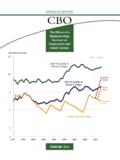Transcription of LABOUR PRODUCTIVITY INDICATORS - OECD.org …
1 Rebecca FREEMAN July 2008 OECD Statistics Directorate Division of Structural Economic Statistics LABOUR PRODUCTIVITY INDICATORS COMPARISON OF TWO OECD DATABASES PRODUCTIVITY DIFFERENTIALS & THE BALASSA-SAMUELSON EFFECT TABLE OF CONTENTS Introduction .. 5 1. A conceptual look: Why measure LABOUR PRODUCTIVITY ? .. 5 2. LABOUR PRODUCTIVITY : A relationship between production and factors of production .. 5 3. Objectives: LABOUR PRODUCTIVITY and uses .. 6 I. Differences between the OECD PRODUCTIVITY Database and the OECD System of Unit LABOUR cost and Related INDICATORS .. 7 A. Different methodologies used by the OECD Statistics Directorate to measure LABOUR PRODUCTIVITY .. 7 A1. OECD PRODUCTIVITY Database .. 7 A2. The OECD System of Unit LABOUR cost and Related INDICATORS .
2 7 B. Differences between the OECD PRODUCTIVITY Database and the OECD System of Unit LABOUR cost and Related INDICATORS .. 9 B1. Updating policies .. 9 B2. Source Data .. 9 Table Differences between the OECD PRODUCTIVITY Database and the OECD System of Unit LABOUR cost and Related INDICATORS .. 10 B3. Output Measure .. 10 Table Correlations: Output measures used by the OECD PRODUCTIVITY Database and the OECD System of Unit LABOUR cost and Related INDICATORS .. 12 B4. LABOUR Input Measure .. 12 Table LABOUR PRODUCTIVITY growth correlations between the OECD PRODUCTIVITY Database and the OECD System of Unit LABOUR cost and Related INDICATORS .. 14 C. Comparison Between the OECD PRODUCTIVITY Database and the OECD System of Unit LABOUR cost and Related INDICATORS .. 15 C1. LABOUR PRODUCTIVITY growth for the total economy.
3 15 C2. Four Central and Eastern European Countries, currently members of the European Union .. 24 C3. Some Conclusions .. 30 II. Analysis of LABOUR PRODUCTIVITY in Industry and Services: an Illustration of the OECD System of Unit LABOUR cost and Related INDICATORS .. 31 A. Recent Historical Background: Focus on Industry and Services Sectors .. 31 A1. Slovak Republic .. 31 A2. Hungary .. 31 A3. Czech Republic .. 32 A4. Poland .. 32 A5. Euro area .. 33 B. Analysis of the Balassa-Samuelson Effect .. 33 B1. Traded goods and non-traded goods sectors .. 33 B2. Theoretical Background .. 34 3 C. Empirical Application: The Balassa-Samuelson Effect in Four Central and Eastern European Countries Compared to the Euro area .. 36 C1. The methodology used to test the Balassa-Samuelson effect .. 36 Box Challenges Measuring LABOUR PRODUCTIVITY In The Service Sector.
4 37 Table Correlations: CPI/PPI and real effective exchange rate .. 38 C2. Application of the OECD System of Unit LABOUR cost and Related INDICATORS .. 39 Conclusion .. 50 Annex 1. Source Data used by the OECD System of Unit LABOUR cost and Related INDICATORS and the OECD PRODUCTIVITY Database .. 52 Annex 2. Series data used by the OECD System of Unit LABOUR cost and Related INDICATORS and the OECD PRODUCTIVITY Database growth rates .. 61 Annex 3. Derivation of the Balassa-Samuelson equation .. 69 Annex 4. Data used in the calculation of the Balassa-Samuelson effect from the OECD System of Unit LABOUR cost and Related INDICATORS .. 73 Bibliography .. 75 4 INTRODUCTION 1. A conceptual look: Why measure LABOUR PRODUCTIVITY ? PRODUCTIVITY is commonly defined as a ratio of a volume measure of output to a measure of input other PRODUCTIVITY measures such as multi-factor PRODUCTIVITY or capital PRODUCTIVITY , LABOUR PRODUCTIVITY is particularly important in the economic and statistical analysis of a country.
5 LABOUR PRODUCTIVITY is a revealing indicator of several economic INDICATORS as it offers a dynamic measure of economic growth, competitiveness, and living standards within an economy. It is the measure of LABOUR PRODUCTIVITY (and all that this measure takes into account) which helps explain the principal economic foundations that are necessary for both economic growth and social 2. LABOUR PRODUCTIVITY : A relationship between production and factors of production Although the ratio used to calculate LABOUR PRODUCTIVITY provides a measure of the efficiency with which inputs are used in an economy to produce goods and services, it can be measured in various ways. LABOUR PRODUCTIVITY is equal to the ratio between a volume measure of output (gross domestic product or gross value added) and a measure of input use (the total number of hours worked or total employment).
6 3 LABOUR PRODUCTIVITY = volume measure of output / measure of input use Volume measure of output: The volume measure of output reflects the goods and services produced by the workforce. Numerator of the ratio of LABOUR PRODUCTIVITY , the volume measure of output is measured either by gross domestic product (GDP) or gross value added (GVA). Although these two different measures can both be used as output measures, there is normally a strong correlation between the two (Table ). There is a preference for value added as taxes are excluded. Measure of input use: The measure of input use reflects the time, effort and skills of the workforce. Denominator of the ratio of LABOUR PRODUCTIVITY , the input measure is the most important factor that influences the measure of LABOUR PRODUCTIVITY (Table ).
7 LABOUR input is measured either by the total number of hours worked of all persons employed or total employment (head count). There are both advantages and disadvantages associated with the different input measures that are used in the calculation of LABOUR PRODUCTIVITY . It is generally accepted that the total number of hours worked is the most appropriate measure of LABOUR input because a simple headcount of employed persons can hide changes in average hours worked, caused by the evolution of part-time work or the effect of variations in overtime, absence from work or shifts in normal hours. However, the quality of hours-worked estimates is not always clear. In particular, statistical establishment and household surveys are difficult to use because of their varying quality of hours-worked estimates and their varying degree of international 1 OECD Publications.
8 Measuring PRODUCTIVITY OECD Manuel: measurement of aggregate and industry-level PRODUCTIVITY growth. 2001, page 11. 2 OECD Publications. Measuring PRODUCTIVITY OECD Manuel: measurement of aggregate and industry-level PRODUCTIVITY growth. 2001, chapter 2. 3 The use of different LABOUR input and output measures can decrease comparability among international LABOUR PRODUCTIVITY measures. 4 OECD Publications. Measuring PRODUCTIVITY OECD Manuel: measurement of aggregate and industry-level PRODUCTIVITY growth. 2001, page 39. 5 In contrast, total employment is easier to measure than the total number of hours worked. However, total employment is less recommended as a measure of LABOUR PRODUCTIVITY because it neither reflects changes in the average work time per employee nor changes in multiple job holdings and the role of self-employed persons (nor in the quality of LABOUR ).
9 5 3. Objectives: LABOUR PRODUCTIVITY and uses The OECD Statistics Directorate (STD) publishes series on LABOUR PRODUCTIVITY for all OECD member countries. The two principal databases that provide such series are the OECD PRODUCTIVITY Database, first published in March 2003, and the OECD System of Unit LABOUR cost and Related INDICATORS , first published in March 2007. Although these two databases both provide series on LABOUR PRODUCTIVITY for the same countries, each database calculates LABOUR PRODUCTIVITY in a different way. In particular, the calculation of both the output and LABOUR input measures differs according to the database used. Therefore, correlations of LABOUR PRODUCTIVITY growth differ for several OECD member countries between the two databases. This report has two principal objectives, the first of which is to compare the OECD PRODUCTIVITY Database and the OECD System of Unit LABOUR cost and Related INDICATORS .
10 Comparing these two databases will both illustrate the different ways of measuring LABOUR PRODUCTIVITY and demonstrate how LABOUR PRODUCTIVITY growth varies when different input and output measures are used. Additionally, correlations between series of LABOUR PRODUCTIVITY growth for the total economy will serve to validate the two databases in relation to one another. The second objective of this report is to give a practical application of the OECD System of Unit LABOUR cost and Related INDICATORS , given that it is a relatively new OECD database. This is important because it is the only OECD database that publishes LABOUR PRODUCTIVITY data according to economic activity. To do this, a composite indicator of LABOUR PRODUCTIVITY in industry versus market services is created in addition to a proxy for relative prices between these same two sectors.














